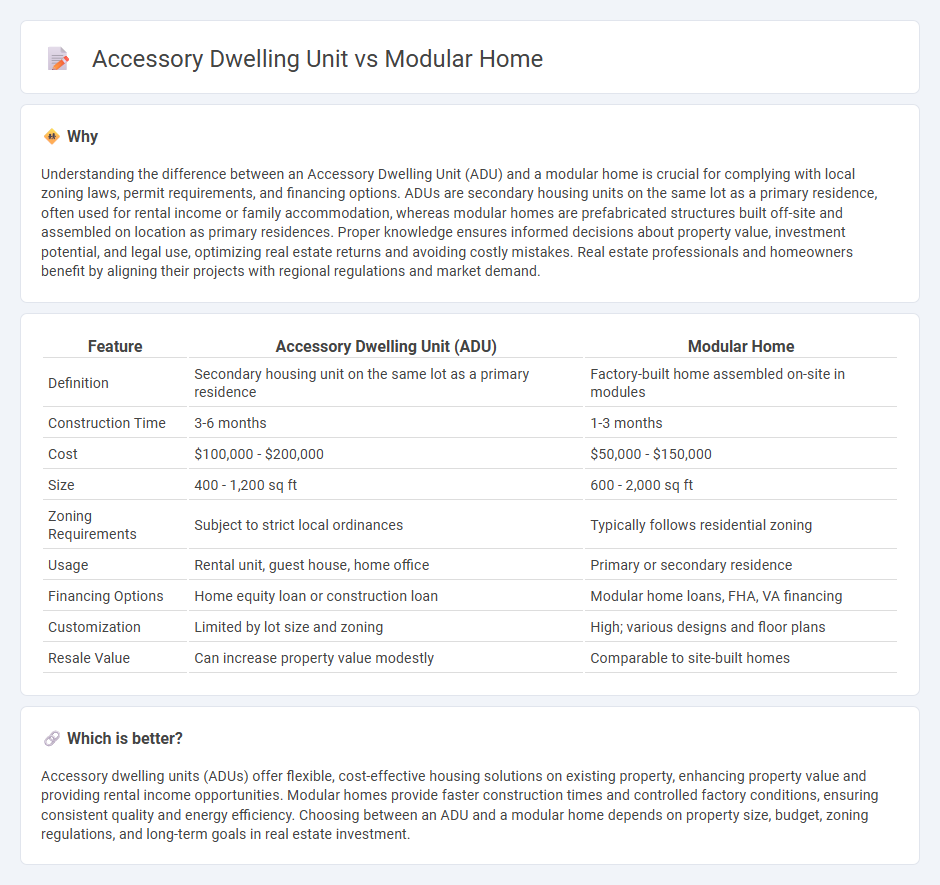
Accessory dwelling units (ADUs) offer versatile, space-efficient housing solutions often built on existing residential properties, providing homeowners with additional rental income or living space. Modular homes are factory-constructed structures delivered and assembled on-site, known for their cost-effectiveness, quicker build times, and customizable designs. Explore the benefits and differences between ADUs and modular homes to find the best fit for your real estate investment or living needs.
Why it is important
Understanding the difference between an Accessory Dwelling Unit (ADU) and a modular home is crucial for complying with local zoning laws, permit requirements, and financing options. ADUs are secondary housing units on the same lot as a primary residence, often used for rental income or family accommodation, whereas modular homes are prefabricated structures built off-site and assembled on location as primary residences. Proper knowledge ensures informed decisions about property value, investment potential, and legal use, optimizing real estate returns and avoiding costly mistakes. Real estate professionals and homeowners benefit by aligning their projects with regional regulations and market demand.
Comparison Table
| Feature | Accessory Dwelling Unit (ADU) | Modular Home |
|---|---|---|
| Definition | Secondary housing unit on the same lot as a primary residence | Factory-built home assembled on-site in modules |
| Construction Time | 3-6 months | 1-3 months |
| Cost | $100,000 - $200,000 | $50,000 - $150,000 |
| Size | 400 - 1,200 sq ft | 600 - 2,000 sq ft |
| Zoning Requirements | Subject to strict local ordinances | Typically follows residential zoning |
| Usage | Rental unit, guest house, home office | Primary or secondary residence |
| Financing Options | Home equity loan or construction loan | Modular home loans, FHA, VA financing |
| Customization | Limited by lot size and zoning | High; various designs and floor plans |
| Resale Value | Can increase property value modestly | Comparable to site-built homes |
Which is better?
Accessory dwelling units (ADUs) offer flexible, cost-effective housing solutions on existing property, enhancing property value and providing rental income opportunities. Modular homes provide faster construction times and controlled factory conditions, ensuring consistent quality and energy efficiency. Choosing between an ADU and a modular home depends on property size, budget, zoning regulations, and long-term goals in real estate investment.
Connection
Accessory dwelling units (ADUs) and modular homes both offer efficient, cost-effective housing solutions that maximize property use and provide additional living space without extensive construction delays. Modular homes, built off-site in controlled environments, can serve as high-quality, customizable ADUs with faster installation times compared to traditional builds. This connection allows homeowners to increase property value and rental income while addressing housing shortages through streamlined, scalable construction methods.
Key Terms
Prefabrication
Prefabrication techniques in modular homes involve constructing large sections or entire units off-site, ensuring precise quality control and reduced onsite assembly time compared to accessory dwelling units (ADUs), which often use prefabricated panels or kits for smaller-scale builds. Modular homes benefit from factory-built modules that are transported and installed quickly, offering higher customization and scalability, while ADUs provide a cost-effective, space-efficient solution primarily for secondary housing needs. Explore the specifics of prefabrication differences to determine which option best fits your housing project.
Zoning
Zoning regulations are critical when comparing modular homes and accessory dwelling units (ADUs), as they directly impact placement, size, and usage permissions within residential zones. Modular homes often require compliance with single-family zoning codes and may face restrictions similar to traditional builds, while ADUs are typically governed by more lenient zoning rules designed to promote affordable housing and increased density. Explore how local zoning laws can shape your property's development options and maximize your investment potential.
Permanent Foundation
Modular homes are built in sections in a factory and installed on permanent foundations, providing structural stability and compliance with local building codes. Accessory dwelling units (ADUs), while sometimes built on permanent foundations, can also be designed as detached or attached structures with varying foundation types depending on zoning regulations. Explore the differences in foundation requirements to determine the best fit for your property.
Source and External Links
Modular Homes from Champion Homes - Offers innovative designs, energy efficiency, and affordability, built in compliance with local building codes.
Modular Home Floorplans | Modular Home Layouts - Provides various modular home floor plans with customization options, ensuring flexibility and cost-effectiveness.
Sunshine Homes: Manufactured & Modular Homes - Offers high-quality modular homes with options for customization and focuses on sustainability and efficiency in construction.
 dowidth.com
dowidth.com